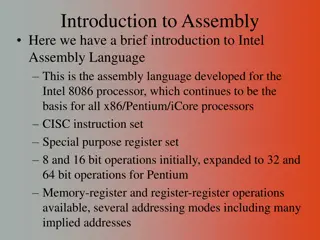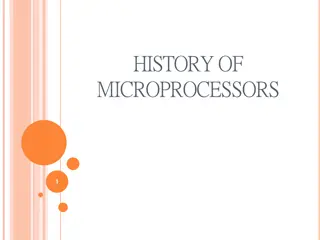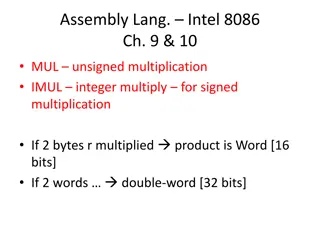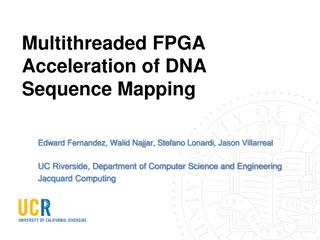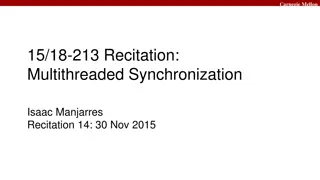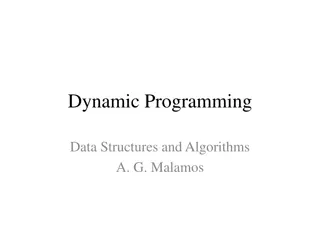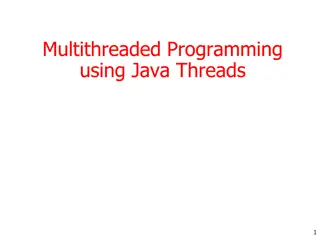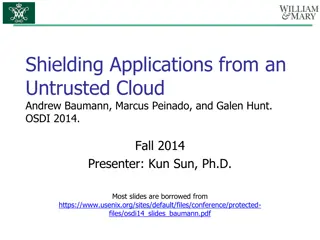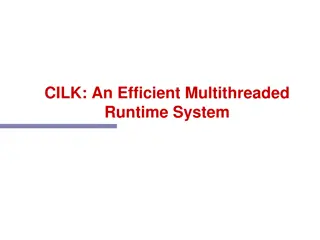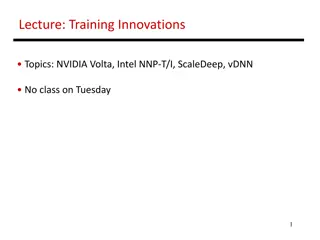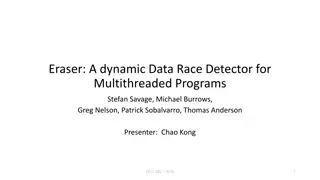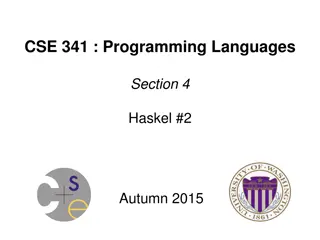Intel Cilk Plus: Programming Dynamic Multithreaded Applications
Intel Cilk Plus is a powerful tool for programming dynamic multithreaded applications on shared-memory multiprocessors. This technology extends the C language with keywords like cilk_spawn, cilk_sync, and cilk_for, making it easier to harness the power of parallelism. Cilk's runtime system manages low-level aspects of parallel execution efficiently, offering benefits such as processor-obliviousness and support for speculative parallelism. Utilize supplementary tools like CilkView and CilkScreen for enhanced performance analysis and optimization.
Download Presentation

Please find below an Image/Link to download the presentation.
The content on the website is provided AS IS for your information and personal use only. It may not be sold, licensed, or shared on other websites without obtaining consent from the author.If you encounter any issues during the download, it is possible that the publisher has removed the file from their server.
You are allowed to download the files provided on this website for personal or commercial use, subject to the condition that they are used lawfully. All files are the property of their respective owners.
The content on the website is provided AS IS for your information and personal use only. It may not be sold, licensed, or shared on other websites without obtaining consent from the author.
E N D
Presentation Transcript
Cilk and Writing Code for Hardware Jyothi Krishna V S Nov 8, 2017
Cilk (Intel Cilk Plus) Cilk C language for programming dynamic multithreaded applications on shared-memory multiprocessors.Cilk s provably good runtime system automatically manages low-level aspects of parallel execution, including protocols, load balancing, and scheduling. Why Cilk is a good starting point? Cilk extends the C language with just a handful of keywords: cilk_spawn, cilk_sync, cilk_for Cilk is processor-oblivious. Cilk supports speculative parallelism. Cool Supplymentary tools: CilkView and CilkScreen.
A new thread created. The child Cilk procedure can execute in parallel with the parent caller. Fibonacci int fib (int n) { if (n<2) return (n); else { int x,y; x = cilk_spawn fib(n-1); y = cilk_spawn fib(n-2); cilk_sync; return (x+y); } } int fib (int n) { if (n<2) return (n); else { int x,y; x = fib(n-1); y = fib(n-2); return (x+y); } } Wait until all spawned children have returned. Cilk Code C Code
Consider n=4 ... Continue Edge Spawn Edge Return Edge Initial Thread Exit int fib (int n) { if (n<2) return (n); else { int x,y; x = cilk_spawn fib(n-1); y = cilk_spawn fib(n-2); cilk_sync; return (x+y); } } 4 3 2 2 1 1 0 1 0
CilkView: A measure of Parallelism Used for performance analysis of Cilk Program Estimates Performance of your code for different number of processors Gives the estimates of Spawns Maximum parallelism Instructions executed etc
Work : Span : Burdened span : Parallelism : Burdened parallelism : Number of spawns/syncs: Average instructions / strand : Strands along span : Average instructions / strand on span : 318 Total number of atomic instructions : Frame count : Entries to parallel region : Speedup Estimate 2 processors: 4 processors: 8 processors: 16 processors: 32 processors: 64 processors: 128 processors: 256 processors: 15,450 instructions 3,826 instructions 263,826 instructions 4.04 0.06 48 106 12 54 CilkView Output 102 2 0.07 - 2.00 0.05 - 4.00 0.04 - 4.04 0.04 - 4.04 0.04 - 4.04 0.03 - 4.04 0.03 - 4.04 0.03 - 4.04
ArraySum cilk_for Spawns n threads int main() { int n = 100; int total; cilk_for(int i = 1; i <= n; ++i) { total += compute(i); } printf( Total is %d , total) } int compute(int i) { return i; } Does this program give the correct answer, 5050? Implicit cilk_sync NOT Always !! A potential race does not always happen at runtime and hence does not guarantee WRONG answer all the time Race on total.
Reduction Defining Reduction operation with variable. int main() { int n = 100; cilk::reducer_opadd<int> total; cilk_for(int i = 1; i <= n; ++i) { total += compute(i); } printf( Total is %d , total) } int compute(int i) { return i; } Reductions can be performed only for conductive operations like Add Xor Max, Min etc.
Cilkscreen: Race Detection Dynamic Race detection software. Race detection is a VERY HARD problem. CilkScreen does not guarantee 100% race free program. ~/cilk/bin/cilkscreen ./a.out No errors found by Cilkscreen Race condition on location 0x1aba310 write access at 0x401329: (~/test/matrix_multiply.cilk:51,__cilk_loop_d_002+0x51) read access at 0x401325: (~/test/matrix_multiply.cilk:51, ..
Cilk Plus Resources Home Page: https://www.cilkplus.org/ Runtime integrated with gcc 4.9 onwards. If you have gcc 4.9 and above just use -fcilkplus flag CilkScreen: https://software.intel.com/en-us/articles/an-introduction-to-the-cilk-screen-race-detector CilkView: https://www.cilkplus.org/tutorial-cilk-tools Load Balancing, Work stealing. Also look into Cacti stack : Cilk Memory Model
Writing Code for Hardware Understanding and coding to the underlying hardware can improve your parallel performance Amdahl's law Speedup S =1/ ((1-p) + p/s ) Actual Speedup = 1/ ((1-p) + p/s + T(s) + S(s)) T(s) : Thread/ task creation cost S(s): Synchronization cost Correctness Parallelism / Scalability Reduction in Communication/ Synchronization Load Balance among Threads Other optimizations Priority
Correctness Subjective to requirement x=1; y= 0; Thread 1: atomic(y = 1); atomic(x = 1); Thread 2: if (x == 1) { atomic(y = 0); } --------------------------- - assert( x || y); Thread 1: x = 3; y = 5; Thread 2: x = 1; y = 4; ---------------------------- assert( x< y); Racy but correct. Race Free but can be incorrect.
Improve Performance Avoid Branches, small kernels High T(s), Moderate S(s) Choice of algorithm (the s factor in Amdahl s law) SSSP : Dijkstra, Bellman-Ford (Scalable) Sequential Dijkstra performs very well. But, Bellman-Ford is nicely parallelizable. Choice of Hardware: CUDA (GPU) / Cilk (CPU) GPU: Scratch Memory, SIMD , larger no of threads CPU: False Sharing, MIMD, Faster threads Avoid False sharing Moderate T(s), Moderate S(s)
Example 1 : CPU False-sharing effect Consider a cache line of 8 word For N = 100,000, Intel core i7, 8 Threads int a[]; Int i; <parallel for> for(i=0;i<N;i++) { a [i] = i+2; }
Example 2: Effect of Branches in GPU Kernel Code: Without branch: void addk(int* dA, int* dB, int* dC) { int id = blockIdx.x * blockDim.x + threadIdx.x; dC[id] = dA[id] + dB[id]; } With Branch: void addk(int* dA, int* dB, int* dC) { int id = blockIdx.x * blockDim.x + threadIdx.x; if(id %2 == 0 ) dC[id] = dA[id] + dB[id]; else dC[id] = dA[id] - dB[id]; } N = 1200000 Does not contain copy cost.



